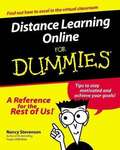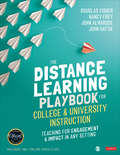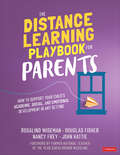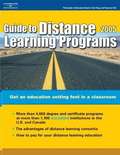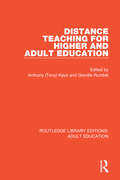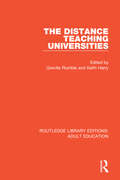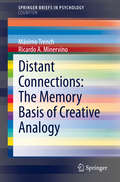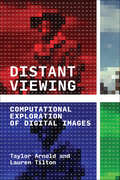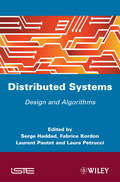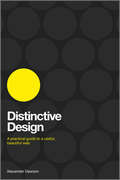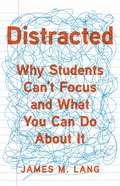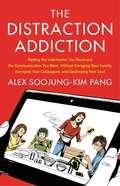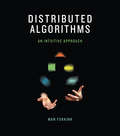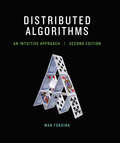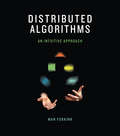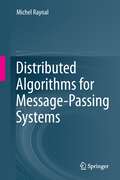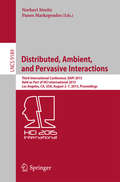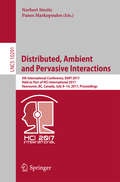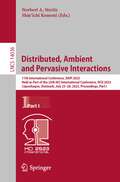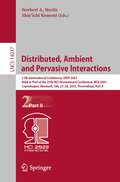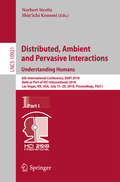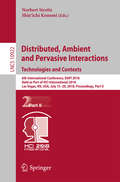- Table View
- List View
Distance Learning Online for Dummies
by Nancy StevensonDistance Learning Online For Dummies is your perfect resource for navigating the rocky waters of distance learning. Find the right school for you, figure out the costs of classes, get registered, and go to school. Each step along this path can be intimidating, unless you have this book! Author Nancy Stevenson makes getting over these hurdles fun, with practical advice that will get you working towards that degree in no time at all. Once you're in class, she'll still be there to help you with correct etiquette for the virtual classroom, study tips, and advice on the best web tools to complement your learning experience! Includes a chapter on distance learning for people with disabilities.
The Distance Learning Playbook for College and University Instruction: Teaching for Engagement and Impact in Any Setting
by Douglas Fisher Nancy Frey John T. Almarode John HattieFirst, let’s commend ourselves: how in the midst of a pandemic we faculty stepped up at record speed to teach in such a foreign learning environment. Try we did, adapt we did, and learn we did. But to be clear, and we already recognize this, this past spring was less about distance learning and more about crisis teaching. This time around we have the opportunity to be much more purposeful and intentional, and that’s where The Distance Learning Playbook for College and University Instruction will prove absolutely indispensable. Much more than a collection of cool tools and apps, The Distance Learning Playbook for College and University Instruction mobilizes decades of Visible Learning® research to reveal those evidence-based strategies that work best in an online environment. Supplemented by video footage and opportunities to self-assess and reflect, the book addresses every dynamic that must be in place for students to learn, even at a distance: Faculty-student relationships from a distance Teacher credibility from a distance Teacher clarity from a distance Engaging tasks from a distance Planning learning experiences from a distance Feedback, assessment, and grading from a distance Keeping the focus on learning, from a distance or otherwise What does our post-COVID future hold? "We suspect," Fisher, Frey, Almarode, and Hattie write, "it will include increased amounts of distance learning. In the meantime, let’s seize on what we have learned to improve post-secondary education in any format, whether face-to-face or from a distance." "We are all still active faculty members, committed to teaching, scholarship, and service. The unexpected transition to remote learning doesn’t mean we no longer know how to teach. We can still impact the lives of our students and know that we made a difference. The Distance Learning Playbook for College and University Instruction will show you how." ~Douglas Fisher, Nancy Frey, John Almarode, and John Hattie
The Distance Learning Playbook for College and University Instruction: Teaching for Engagement and Impact in Any Setting
by Douglas Fisher Nancy Frey John T. Almarode John HattieFirst, let’s commend ourselves: how in the midst of a pandemic we faculty stepped up at record speed to teach in such a foreign learning environment. Try we did, adapt we did, and learn we did. But to be clear, and we already recognize this, this past spring was less about distance learning and more about crisis teaching. This time around we have the opportunity to be much more purposeful and intentional, and that’s where The Distance Learning Playbook for College and University Instruction will prove absolutely indispensable. Much more than a collection of cool tools and apps, The Distance Learning Playbook for College and University Instruction mobilizes decades of Visible Learning® research to reveal those evidence-based strategies that work best in an online environment. Supplemented by video footage and opportunities to self-assess and reflect, the book addresses every dynamic that must be in place for students to learn, even at a distance: Faculty-student relationships from a distance Teacher credibility from a distance Teacher clarity from a distance Engaging tasks from a distance Planning learning experiences from a distance Feedback, assessment, and grading from a distance Keeping the focus on learning, from a distance or otherwise What does our post-COVID future hold? "We suspect," Fisher, Frey, Almarode, and Hattie write, "it will include increased amounts of distance learning. In the meantime, let’s seize on what we have learned to improve post-secondary education in any format, whether face-to-face or from a distance." "We are all still active faculty members, committed to teaching, scholarship, and service. The unexpected transition to remote learning doesn’t mean we no longer know how to teach. We can still impact the lives of our students and know that we made a difference. The Distance Learning Playbook for College and University Instruction will show you how." ~Douglas Fisher, Nancy Frey, John Almarode, and John Hattie
The Distance Learning Playbook for Parents: How to Support Your Child′s Academic, Social, and Emotional Development in Any Setting
by Rosalind Wiseman Douglas Fisher Nancy Frey John HattieWe are in this together and will get through this together Parent involvement has always been a vital part of any child’s education, but the pandemic and resulting remote instruction require that parents and educators partner at a deeper level. Following the tremendous success of The Distance Learning Playbook, K-12, education authorities Doug Fisher, Nancy Frey, and John Hattie have teamed up with New York Times bestselling author and parenting expert Rosalind Wiseman to bring you the consummate guide to support your child′s academic, social, and emotional development in any learning environment – while not overwhelming you in the process. This essential guide will arm you with the tools and insight to Create an environment conducive to learning, establish routines, and most importantly, take care of yourself and your child Maximize the time you spend supporting learning by focusing on what is proven to work best in education Help your child develop the cognitive attitudes and habits that foster creativity, critical thinking, and increased responsibility for their learning Support the development of your child’s social and emotional learning skills, including the ability to navigate social interactions, build friendships, and regulate emotions at a time when they have never been more important to have, and more challenging to maintain The Distance Learning Playbook for Parents outlines supportive strategies for navigating virtual environments to ensure effective and impactful learning that aligns the needs and expectations of teachers, parents, and students alike.
The Distance Learning Playbook for Parents: How to Support Your Child′s Academic, Social, and Emotional Development in Any Setting
by Rosalind Wiseman Douglas Fisher Nancy Frey John HattieWe are in this together and will get through this together Parent involvement has always been a vital part of any child’s education, but the pandemic and resulting remote instruction require that parents and educators partner at a deeper level. Following the tremendous success of The Distance Learning Playbook, K-12, education authorities Doug Fisher, Nancy Frey, and John Hattie have teamed up with New York Times bestselling author and parenting expert Rosalind Wiseman to bring you the consummate guide to support your child′s academic, social, and emotional development in any learning environment – while not overwhelming you in the process. This essential guide will arm you with the tools and insight to Create an environment conducive to learning, establish routines, and most importantly, take care of yourself and your child Maximize the time you spend supporting learning by focusing on what is proven to work best in education Help your child develop the cognitive attitudes and habits that foster creativity, critical thinking, and increased responsibility for their learning Support the development of your child’s social and emotional learning skills, including the ability to navigate social interactions, build friendships, and regulate emotions at a time when they have never been more important to have, and more challenging to maintain The Distance Learning Playbook for Parents outlines supportive strategies for navigating virtual environments to ensure effective and impactful learning that aligns the needs and expectations of teachers, parents, and students alike.
Distance Learning Programs 2005
by Peterson'sFeatures include: Descriptions of more than 3,500 degree and certificate programs; Financial aid options specifically for distance learners; Accreditation--what it's all about and why it's important; Information on distance learning consortia--the next big thing in distance learning; Tips on choosing the right program.
Distance Teaching For Higher and Adult Education (Routledge Library Editions: Adult Education)
by Anthony Tony Kaye And Greville RumbleOriginally published in 1981 this volume provides a detailed analysis of the factors - strategic, pedagogic, operational, organisational and financial -which should be taken into account in the planning and running of large-scale, centralised distance education systems at the higher education level. The book uses evidence drawn from Open University type institutions in Canada, Costa Rica, Germany, Iran, Israel, Pakistan, Spain, Sri Lanka, Venezuela and the UK.
The Distance Teaching Universities (Routledge Library Editions: Adult Education)
by Greville Rumble, Keith HarryOriginally published in 1982 this volume provides nine case studies of particular distance teaching universities in Canada, China, Cost Rica, Germany, Israel, Pakistan, Spain, Venezuela and the UK. These universities were mainly founded in the 1970s to teach only at a distance. The book considers the provision of distance education by universities in general and the development and characteristics of the distance teaching universities in particular. Chronicling the emergence of new university structures between 1971-1981, the book also provides an appraisal of their performance in the early years.
Distant Connections: The Memory Basis of Creative Analogy (SpringerBriefs in Psychology)
by Máximo Trench Ricardo A. MinervinoAnalogical thinking lies at the core of human cognition, pervading from the most mundane to the most extraordinary forms of creativity. By connecting poorly understood phenomena to learned situations whose structure is well articulated, it allows reasoners to expand the boundaries of their knowledge. The first part of the book begins by fleshing out the debate around whether our cognitive system is well-suited for creative analogizing, and ends by reviewing a series of studies that were designed to decide between the experimental and the naturalistic accounts. The studies confirm the psychological reality of the surface bias revealed by most experimental studies, thus claiming for realistic solutions to the problem of inert knowledge. The second part of the book delves into cognitive interventions, while maintaining an emphasis on the interplay between psychological modeling and instructional applications. It begins by reviewing the first generation of instructional interventions aimed at improving the later retrievability of educational contents by highlighting their abstract structure. Subsequent chapters discuss the most realistic avenues for devising easily-executable and widely-applicable ways of enhancing access to stored knowledge that would otherwise remain inert. The authors review results from studies from both others and their own lab that speak of the promise of these approaches.
Distant Horizons: Digital Evidence and Literary Change
by Ted UnderwoodJust as a traveler crossing a continent won’t sense the curvature of the earth, one lifetime of reading can’t grasp the largest patterns organizing literary history. This is the guiding premise behind Distant Horizons, which uses the scope of data newly available to us through digital libraries to tackle previously elusive questions about literature. Ted Underwood shows how digital archives and statistical tools, rather than reducing words to numbers (as is often feared), can deepen our understanding of issues that have always been central to humanistic inquiry. Without denying the usefulness of time-honored approaches like close reading, narratology, or genre studies, Underwood argues that we also need to read the larger arcs of literary change that have remained hidden from us by their sheer scale. Using both close and distant reading to trace the differentiation of genres, transformation of gender roles, and surprising persistence of aesthetic judgment, Underwood shows how digital methods can bring into focus the larger landscape of literary history and add to the beauty and complexity we value in literature.
Distant Viewing: Computational Exploration of Digital Images
by Taylor Arnold Lauren TiltonA new theory and methodology for the application of computer vision methods to the computational analysis of collected, digitized visual materials, called &“distant viewing.&”Distant Viewing: Computational Exploration of Digital Images presents a new theory and methodology for the computational analysis of digital images, offering a lively, constructive critique of computer vision that you can actually use. What does it mean to say that computer vision &“understands&” visual inputs? Annotations never capture a whole image. The way digital images convey information requires what researchers Taylor Arnold and Lauren Tilton call &“distant viewing&”—a play on the well-known term &“distant reading&” from computational literary analysis.Recognizing computer vision&’s limitations, Arnold and Tilton&’s spirited examination makes the technical exciting by applying distant viewing to the sitcoms Bewitched and I Dream of Jeannie, movie posters and other popular forms of advertising, and Dorothea Lange&’s photography. In the tradition of visual culture studies and computer vision, Distant Viewing&’s interdisciplinary perspective encompasses film and media studies, visual semiotics, and the sciences to create a playful, accessible guide for an international audience working in digital humanities, data science, media studies, and visual culture studies.
Distibuted Systems: Design and Algorithms (Wiley-iste Ser.)
by Serge Haddad Fabrice Kordon Laurent Pautet Laure PetrucciIn today’s digital environment, distributed systems are increasingly present in a wide variety of environments, ranging from public software applications to critical systems. Distributed Systems introduces the underlying concepts, the associated design techniques and the related security issues. Distributed Systems: Design and Algorithms, is dedicated to engineers, students, and anyone familiar with algorithms and programming, who want to know more about distributed systems. These systems are characterized by: several components with one or more threads, possibly running on different processors; asynchronous communications with possible additional assumptions (reliability, order preserving, etc.); local views for every component and no shared data between components. This title presents distributed systems from a point of view dedicated to their design and their main principles: the main algorithms are described and placed in their application context, i.e. consistency management and the way they are used in distributed file-systems.
Distinctive Design
by Alexander DawsonLearn to produce a web site that stands out from the crowdOne of the web designer's greatest challenges is to create a site distinctive enough to get noticed among the millions of sites already on the web. This book examines the bond between code, content and visuals to guide you through the factors that increase your design's visibility, usability and beauty. Using this practical advice, even web designers who lack strong artistic skills can develop super sites that strengthen the message and stand out from the crowd.Most books focus primarily on graphic design principles; this one shows you how to maximize and prioritize every design decision to help your site achieve its primary purpose: showcasing your content and servicesExplores the bond between code, content and visuals to guide you through the factors that increase your design's visibility, usability and beautyEnables even artistically challenged web designers to create elegant, functional layouts that attract visitors and are user-friendlyEvery web designer can benefit from this practical advice on creating an informative, attractive, easy-to-use site that gets noticed.
Distracted: Why Students Can't Focus and What You Can Do About It
by James M. LangKeeping students focused can be difficult in a world filled with distractions -- which is why a renowned educator created a scientific solution to one of every teacher's biggest problems.Why is it so hard to get students to pay attention? Conventional wisdom blames iPhones, insisting that access to technology has ruined students' ability to focus. The logical response is to ban electronics in class. But acclaimed educator James M. Lang argues that this solution obscures a deeper problem: how we teach is often at odds with how students learn. Classrooms are designed to force students into long periods of intense focus, but emerging science reveals that the brain is wired for distraction. We learn best when able to actively seek and synthesize new information. In Distracted, Lang rethinks the practice of teaching, revealing how educators can structure their classrooms less as distraction-free zones and more as environments where they can actively cultivate their students' attention. Brimming with ideas and grounded in new research, Distracted offers an innovative plan for the most important lesson of all: how to learn.
The Distraction Addiction: Getting the Information You Need and the Communication You Want, Without Enraging Your Family, Annoying Your Colleagues, and Destroying Your Soul
by Alex Soojung-Kim PangThe question of our time: can we reclaim our lives in an age that feels busier and more distracting by the day? We've all found ourselves checking email at the dinner table, holding our breath while waiting for Outlook to load, or sitting hunched in front of a screen for an hour longer than we intended. Mobile devices and the web have invaded our lives, and this is a big idea book that addresses one of the biggest questions of our age: can we stay connected without diminishing our intelligence, attention spans, and ability to really live? Can we have it all? Alex Soojung-Kim Pang, a renowned Stanford technology guru, says yes. THE DISTRACTION ADDICTION is packed with fascinating studies, compelling research, and crucial takeaways. Whether it's breathing while Facebook refreshes, or finding creative ways to take a few hours away from the digital crush, this book is about the ways to tune in without tuning out.
Distributed Algorithms: An Intuitive Approach
by Wan FokkinkThis book offers students and researchers a guide to distributed algorithms that emphasizes examples and exercises rather than the intricacies of mathematical models. It avoids mathematical argumentation, often a stumbling block for students, teaching algorithmic thought rather than proofs and logic. This approach allows the student to learn a large number of algorithms within a relatively short span of time. Algorithms are explained through brief, informal descriptions, illuminating examples, and practical exercises. The examples and exercises allow readers to understand algorithms intuitively and from different perspectives. Proof sketches, arguing the correctness of an algorithm or explaining the idea behind fundamental results, are also included. An appendix offers pseudocode descriptions of many algorithms.Distributed algorithms are performed by a collection of computers that send messages to each other or by multiple software threads that use the same shared memory. The algorithms presented in the book are for the most part "classics," selected because they shed light on the algorithmic design of distributed systems or on key issues in distributed computing and concurrent programming. Distributed Algorithms can be used in courses for upper-level undergraduates or graduate students in computer science, or as a reference for researchers in the field.
Distributed Algorithms: An Intuitive Approach
by Wan FokkinkThe new edition of a guide to distributed algorithms that emphasizes examples and exercises rather than the intricacies of mathematical models. This book offers students and researchers a guide to distributed algorithms that emphasizes examples and exercises rather than the intricacies of mathematical models. It avoids mathematical argumentation, often a stumbling block for students, teaching algorithmic thought rather than proofs and logic. This approach allows the student to learn a large number of algorithms within a relatively short span of time. Algorithms are explained through brief, informal descriptions, illuminating examples, and practical exercises. The examples and exercises allow readers to understand algorithms intuitively and from different perspectives. Proof sketches, arguing the correctness of an algorithm or explaining the idea behind fundamental results, are also included. The algorithms presented in the book are for the most part “classics,” selected because they shed light on the algorithmic design of distributed systems or on key issues in distributed computing and concurrent programming. This second edition has been substantially revised. A new chapter on distributed transaction offers up-to-date treatment of database transactions and the important evolving area of transactional memory. A new chapter on security discusses two exciting new topics: blockchains and quantum cryptography. Sections have been added that cover such subjects as rollback recovery, fault-tolerant termination detection, and consensus for shared memory. An appendix offers pseudocode descriptions of many algorithms. Solutions and slides are available for instructors.Distributed Algorithms can be used in courses for upper-level undergraduates or graduate students in computer science, or as a reference for researchers in the field.
Distributed Algorithms: An Intuitive Approach (The\mit Press Ser.)
by Wan FokkinkA comprehensive guide to distributed algorithms that emphasizes examples and exercises rather than mathematical argumentation.This book offers students and researchers a guide to distributed algorithms that emphasizes examples and exercises rather than the intricacies of mathematical models. It avoids mathematical argumentation, often a stumbling block for students, teaching algorithmic thought rather than proofs and logic. This approach allows the student to learn a large number of algorithms within a relatively short span of time. Algorithms are explained through brief, informal descriptions, illuminating examples, and practical exercises. The examples and exercises allow readers to understand algorithms intuitively and from different perspectives. Proof sketches, arguing the correctness of an algorithm or explaining the idea behind fundamental results, are also included. An appendix offers pseudocode descriptions of many algorithms.Distributed algorithms are performed by a collection of computers that send messages to each other or by multiple software threads that use the same shared memory. The algorithms presented in the book are for the most part “classics,” selected because they shed light on the algorithmic design of distributed systems or on key issues in distributed computing and concurrent programming.Distributed Algorithms can be used in courses for upper-level undergraduates or graduate students in computer science, or as a reference for researchers in the field.
Distributed Algorithms for Message-Passing Systems
by Michel RaynalDistributed computing is at the heart of many applications. It arises as soon as one has to solve a problem in terms of entities -- such as processes, peers, processors, nodes, or agents -- that individually have only a partial knowledge of the many input parameters associated with the problem. In particular each entity cooperating towards the common goal cannot have an instantaneous knowledge of the current state of the other entities. Whereas parallel computing is mainly concerned with 'efficiency', and real-time computing is mainly concerned with 'on-time computing', distributed computing is mainly concerned with 'mastering uncertainty' created by issues such as the multiplicity of control flows, asynchronous communication, unstable behaviors, mobility, and dynamicity. While some distributed algorithms consist of a few lines only, their behavior can be difficult to understand and their properties hard to state and prove. The aim of this book is to present in a comprehensive way the basic notions, concepts, and algorithms of distributed computing when the distributed entities cooperate by sending and receiving messages on top of an asynchronous network. The book is composed of seventeen chapters structured into six parts: distributed graph algorithms, in particular what makes them different from sequential or parallel algorithms; logical time and global states, the core of the book; mutual exclusion and resource allocation; high-level communication abstractions; distributed detection of properties; and distributed shared memory. The author establishes clear objectives per chapter and the content is supported throughout with illustrative examples, summaries, exercises, and annotated bibliographies. This book constitutes an introduction to distributed computing and is suitable for advanced undergraduate students or graduate students in computer science and computer engineering, graduate students in mathematics interested in distributed computing, and practitioners and engineers involved in the design and implementation of distributed applications. The reader should have a basic knowledge of algorithms and operating systems.
Distributed, Ambient and Pervasive Interactions
by Panos Markopoulos Norbert StreitzThis book constitutes the refereed proceedings of the 5th International Conference on Distributed, Ambient and Pervasive Interactions, DAPI 2013, held as part of the 15th International Conference on Human-Computer Interaction, HCII 2013, held in Las Vegas, USA in July 2013, jointly with 12 other thematically similar conferences. The total of 1666 papers and 303 posters presented at the HCII 2013 conferences was carefully reviewed and selected from 5210 submissions. These papers address the latest research and development efforts and highlight the human aspects of design and use of computing systems. The papers accepted for presentation thoroughly cover the entire field of human-computer interaction, addressing major advances in knowledge and effective use of computers in a variety of application areas. The total of 54 contributions was carefully reviewed and selected for inclusion in the DAPI proceedings. The papers are organized in the following topical sections: natural interaction; context-awareness in smart and intelligent environments; design and evaluation of smart and intelligent environments; smart cities; multi-user, group and collaborative interaction; smart everyday living and working environments.
Distributed, Ambient and Pervasive Interactions: 5th International Conference, DAPI 2017, Held as Part of HCI International 2017, Vancouver, BC, Canada, July 9–14, 2017, Proceedings (Lecture Notes in Computer Science #10291)
by Panos Markopoulos Norbert StreitzThis book constitutes the refereed proceedings of the 5th International Conference on Distributed, Ambient and Pervasive Interactions, DAPI 2013, held as part of the 15th International Conference on Human-Computer Interaction, HCII 2013, held in Las Vegas, USA in July 2013, jointly with 12 other thematically similar conferences. The total of 1666 papers and 303 posters presented at the HCII 2013 conferences was carefully reviewed and selected from 5210 submissions. These papers address the latest research and development efforts and highlight the human aspects of design and use of computing systems. The papers accepted for presentation thoroughly cover the entire field of human-computer interaction, addressing major advances in knowledge and effective use of computers in a variety of application areas. The total of 54 contributions was carefully reviewed and selected for inclusion in the DAPI proceedings. The papers are organized in the following topical sections: natural interaction; context-awareness in smart and intelligent environments; design and evaluation of smart and intelligent environments; smart cities; multi-user, group and collaborative interaction; smart everyday living and working environments.
Distributed, Ambient and Pervasive Interactions: 11th International Conference, DAPI 2023, Held as Part of the 25th HCI International Conference, HCII 2023, Copenhagen, Denmark, July 23–28, 2023, Proceedings, Part I (Lecture Notes in Computer Science #14036)
by Norbert A. Streitz Shin’ichi KonomiThis book constitutes the refereed proceedings of the 11th International Conference on Distributed, Ambient and Pervasive Interactions, DAPI 2023, held as part of the 25th International Conference on Human-Computer Interaction, HCII 2023, which took place as an hybrid event in Copenhagen, Denmark, in July 2023.A total of 1578 papers and 396 posters have been accepted for publication in the HCII 2023 proceedings from a total of 7472 submissions.The 60 papers included in the DAPI 2023 proceedings were organized in topical sections as follows:Part I: Designing and evaluating intelligent environments; user experience in intelligent environments; pervasive data;Part II: Smart cities and environment preservation; media, art and culture in intelligent environments; supporting health, learning, work and everyday life.
Distributed, Ambient and Pervasive Interactions: 11th International Conference, DAPI 2023, Held as Part of the 25th HCI International Conference, HCII 2023, Copenhagen, Denmark, July 23–28, 2023, Proceedings, Part II (Lecture Notes in Computer Science #14037)
by Norbert A. Streitz Shin’ichi KonomiThis book constitutes the refereed proceedings of the 11th International Conference on Distributed, Ambient and Pervasive Interactions, DAPI 2023, held as part of the 25th International Conference on Human-Computer Interaction, HCII 2023, which took place as an hybrid event in Copenhagen, Denmark, in July 2023.A total of 1578 papers and 396 posters have been accepted for publication in the HCII 2023 proceedings from a total of 7472 submissions. The 60 papers included in the DAPI 2023 proceedings were organized in topical sections as follows: Part I: Designing and evaluating intelligent environments; user experience in intelligent environments; pervasive data; Part II: Smart cities and environment preservation; media, art and culture in intelligent environments; supporting health, learning, work and everyday life.
Distributed, Ambient and Pervasive Interactions: 6th International Conference, DAPI 2018, Held as Part of HCI International 2018, Las Vegas, NV, USA, July 15–20, 2018, Proceedings, Part I (Lecture Notes in Computer Science #10921)
by Norbert Streitz Shin’ichi KonomiThis two volume set constitutes the refereed proceedings of the 6th International Conference on Distributed, Ambient and Pervasive Interactions, DAPI 2018, held as part of the 20th International Conference on Human-Computer Interaction, HCII 2018, held in Las Vegas, NV, USA in July 2018. The total of 1171 papers and 160 posters presented at the 14 colocated HCII 2018 conferences. The papers were carefully reviewed and selected from 4346 submissions. These papers address the latest research and development efforts and highlight the human aspects of design and use of computing systems. The papers thoroughly cover the entire field of Human-Computer Interaction, addressing major advances in knowledge and effective use of computers in a variety of application areas.. The LNCS 10921 and LNCS 10922 contains papers addressing the following major topics: Technologies and Contexts ( Part I) and Understanding Humans (Part IΙ)
Distributed, Ambient and Pervasive Interactions: 6th International Conference, DAPI 2018, Held as Part of HCI International 2018, Las Vegas, NV, USA, July 15–20, 2018, Proceedings, Part II (Lecture Notes in Computer Science #10922)
by Norbert Streitz Shin’ichi KonomiThis two volume set constitutes the refereed proceedings of the 6th International Conference on Distributed, Ambient and Pervasive Interactions, DAPI 2018, held as part of the 20th International Conference on Human-Computer Interaction, HCII 2018, held in Las Vegas, NV, USA in July 2018. The total of 1171 papers and 160 posters presented at the 14 colocated HCII 2018 conferences. The papers were carefully reviewed and selected from 4346 submissions. These papers address the latest research and development efforts and highlight the human aspects of design and use of computing systems. The papers thoroughly cover the entire field of Human-Computer Interaction, addressing major advances in knowledge and effective use of computers in a variety of application areas..TheLNCS 10921 and LNCS 10922 contains papers addressing the following major topics: Technologies and Contexts ( Part I) and Understanding Humans (Part IΙ)
